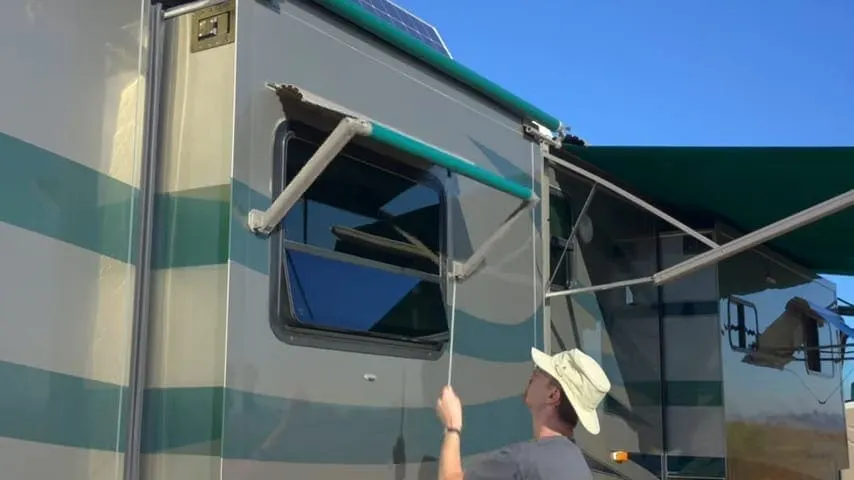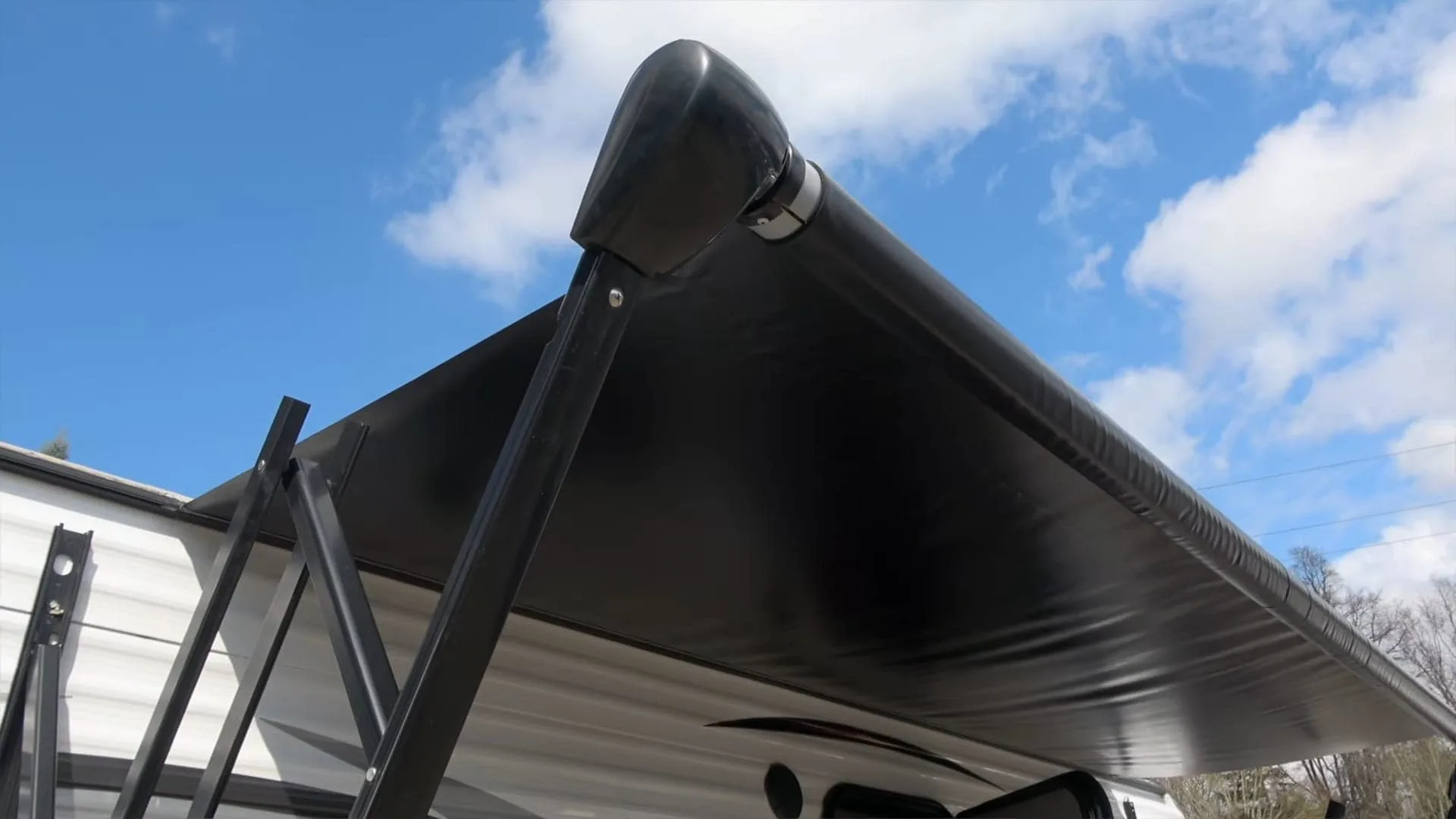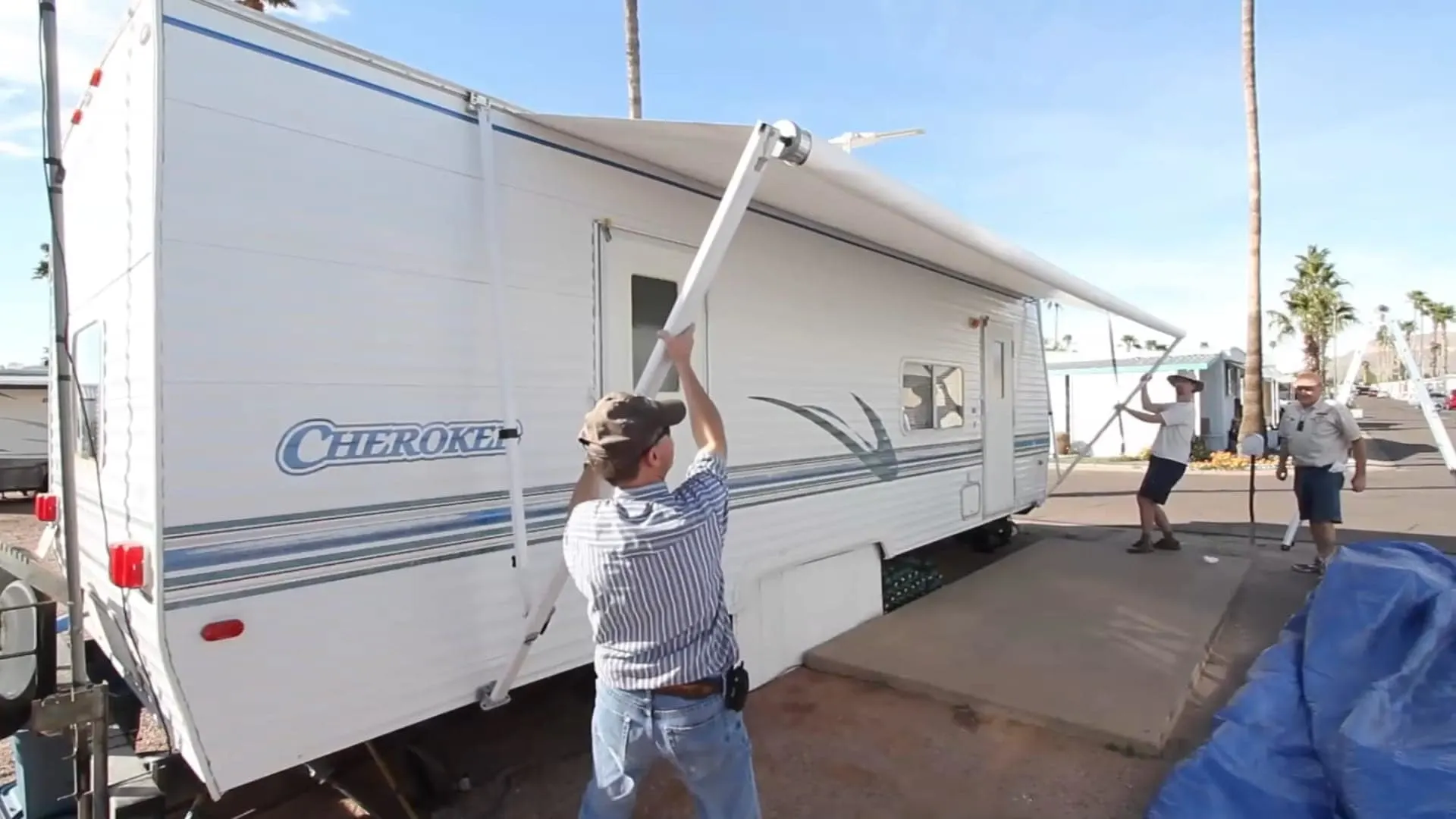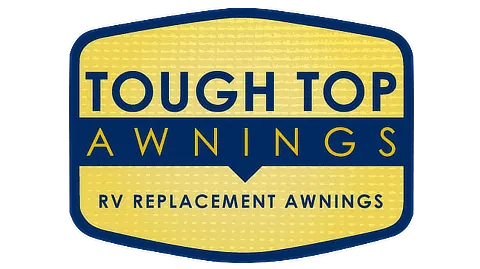An RV awning is an integral part of your rig, making outdoor living more comfortable. You can enjoy the weather without getting burned to a crisp in the summer sun, and it offers additional protected space when it’s raining, making your RV a better indoor-outdoor space.
But you need to take care of your awning if you want it to last. Keep reading to find out the best ways to protect these important pieces of RV equipment.
About RV Awnings
RVs can have more than one type of awning. In addition to a traditional main patio awning, some RVs also have awnings over the door and/or windows.
The main patio awning is the largest one on any RV. It usually extends quite far out, and provides a wonderful shady spot outside your rig. There are also smaller awning models for your windows, which have similar benefits, keeping your rig cooler in the sun, and allowing you to leave windows open without it raining in.
A larger patio awning usually comes standard with most RVs, but window awnings are often an upgrade feature. They’re a fantastic addition, especially during the summer.
If your RV didn’t come with window awnings, you can watch our video to see how to install one here:
Or view our post with written instructions for installing a window awning.

Some RV awnings are manually extended while others are electrically operated with the push of a button.
RV awnings can either be manually or electrically operated. If manual, you’ll pull it out, extend the arms, and lock everything in place by hand. An electric RV awning opens and closes with the press of a button.
RV window awnings provide additional protection from the sun. They extend at a 45-degree angle to cast a shadow over your RV windows, keeping your rig cooler. All except the highest-end window awnings are manually operated. They pull out and roll up using an awning rod. Support arms help them stay in place when extended.
How Much Wind Can an RV Awning Withstand?
While RV awnings are usually fairly robust, they can also be large enough to catch a lot of wind and are expensive to repair or replace. An awning ripped loose in strong winds can also damage your RV (picture the fabric and/or arms flapping around in the wind, and you can imagine the ancillary damage that could result). You should retract them any time winds get too high.
That’s especially important for a large patio awning, which is most subject to wind damage due to its size. In general, we don’t leave our main patio awning out at night, or any time we’re away from the RV. Wind gusts can come up suddenly, and the last thing we want is to wake up to, or return to, an awning that’s been damaged.
Electrically-operated awnings often come with built-in wind sensors that automatically retract the awning for you (or prevent you from extending it) if the wind is too strong. Some sense wind speed directly. Newer models actually sense the motion of the awning arms. Both are designed to protect your awning from damage… but even so, you shouldn’t rely on them alone. Sudden gusts can do significant damage before the awning can retract. Of course, for awnings without an automatic retraction mechanism, you’ll have to retract your awning(s) yourself.
There is no hard-and-fast rule for when to retract your awning. We can’t tell you “If winds exceed XX mph, you should retract the awning.” How big is the awning (is it your patio or window awning)? Is the wind coming from the opposite side of the RV, or is it blowing directly from the awning side? Is your (manual) patio awning staked down? Is there the possibility of sudden wind gusts? All of these things are factors you need to consider.
The best rule of thumb to follow is that if you’re thinking/wondering if it’s getting too windy for your awning, it’s probably already (past?!?!) time to stow it.
What Can High Winds Do to an RV Awning?
Here are a few things that could result if you leave your RV awnings unrolled on windy days:
Tear Off Your Awning
If winds are powerful enough, they can rip the awning clear off your RV. This can cause a lot of damage to your rig, including scratched or gouged bodywork, broken windows, and more. It could also injure someone nearby.
Damage Your RV from Whipping Awning Around

Damage can occur if the arms of your RV awning break in the wind and slam against your RV’s body or windows.
A typical main patio awning can probably weigh about 70 pounds or more. Now imagine a 70-pound metal rod slamming into your RV. You can probably picture the damage already. The worst part? It could happen repeatedly if only one side detaches.
Window awnings can flap around similarly, smashing your windows and bodywork.
Break or Bend Awning Arms
Even if your awning fabric doesn’t tear/rip off, you could still have costly repairs, not to mention a lot of hassle. Strong winds can bend or break the awning arms themselves. You can replace just the arms for some RVs, but you may need to replace the entire unit. Either option is an unnecessary expense and inconvenience.
And with the arms bent/broken, you’ll also have difficulty being able to properly secure the awning for travel. This means you may have to get creative with bungee cords and duct tape, or be prepared to repair, remove, or replace it before you can drive the rig.
Rip Fabric
Gusty winds can also rip your awning fabric. You can likely (temporarily) fix small tears with awning repair tape. But for larger ones, you’ll have to completely replace the fabric instead (RV awning fabric replacement is one of our favorite DIY projects… and we have lots of videos for different awning/slidetopper makes and models).
How to Protect Your RV Awning from Wind
There are a few simple steps you can take to prevent the types of incidents mentioned above from happening to you. Here are our recommendations:
De-Flapper Clamps
The term “de-flapper clamps” might sound a little funny, but when you think about how your RV awning works, they make complete sense.
When you extend your awning, it only holds the fabric in place on two sides: where it’s attached to the RV and on the outer end where the tube is. That leaves the sides to flap in the breeze.
This flapping is annoying on a breezy day, and on a windy day, it can cause the fabric to tear. De-flapper clamps attach to the awning support arms and then clamp the fabric in place, helping to prevent flapping or tearing in the wind.
Stabilizer Kit

Using de-flapper clips or staking down your RV awning will help to stabilize it, but be sure to bring it in when winds pick up.
A stabilizer kit is another inexpensive yet protective option. The kit includes two spiral stakes, rope, and a connector to add to your awning. Think of it like staking down a tent to prevent flapping in the wind.
If you have a concrete or gravel pad, you might not be able to screw the stakes into the ground, so keep this in mind before purchasing.
Always Roll It Up When You Go to Bed or Leave
The best way to protect your RV awning is to roll it up when you aren’t around or if you’re sleeping. There’s no sense in having your shelter extended when you’re away. It may help reduce the temperature inside your RV, but it isn’t worth the risk when you’re not around to stow the awning if the wind picks up.
The same goes for when you’re sleeping. It might seem like a hassle to roll up, especially if you have a manual awning. But it’s a bigger hassle to fix the damage or replace the awning. We never go to sleep with our patio awning extended (although we do have the advantage of it being an electric model, so pushing the button is a simple task).
By rolling up the canopy, you protect it from unexpected changes in the weather or sudden gusts. Even if you’re using de-flapper clamps and a stabilizer kit, this is still the best course of action.
Many power patio awnings are equipped with wind sensors, designed to retract them in the event of windy conditions. We suggest that you consider that only as a back-up, and not assume you can simply ignore weather conditions and leave your awning out all the time.
What to Do If Your RV Awning Is Damaged by Wind
If the wind rips the fabric, you may be able to repair it with a patch kit… or replace the fabric yourself. RV awning fabric replacement is one of our favorite DIY projects… and we have lots of videos for different awning/slidetopper makes and models.
The original equipment fabric that comes on RV awnings and slidetoppers is... well, how do we say this?... CRAP!. It's no surprise, since the RV manufacturers are looking to cut their costs...Show More
The original equipment fabric that comes on RV awnings and slidetoppers is... well, how do we say this?... CRAP!. It's no surprise, since the RV manufacturers are looking to cut their costs. Instead of replacing it with the same stuff that failed in the first place, get high-quality replacement fabric from Tough Top Awnings, instead.
Check out our Tough Top Awnings videos here
Plus you can save 5% on your entire order from Tough Top Awnings. The coupon code is valid online or over the phone!
Show LessIf the awning hardware (arms, support legs, roller tube, etc) is bent or broken, you’ll probably have to replace it entirely. Depending on how handy you are, you might fix or replace it yourself. Otherwise, a professional can do the job.
Having an RV awning is awesome. It makes your outdoor living area much more comfortable. Both patio and window awnings can also keep your RV cooler in the summer.
But as with most RV gear, you need to take care of it. Fortunately, proper care is pretty simple with RV awnings. If it gets windy, just roll it up. If you want extra security, buy stake-down kits to secure it. This way you’ll be able to enjoy your awning(s) on the next nice day instead of dealing with costly repairs.
Geek Out with Us Every Week
Join our newsletter to learn about all things RV-related. Every week we offer free tips, tricks, product reviews, and more to our online community of RVers. Whether this is your first time on the road or you’re a seasoned expert, we’d love for you to geek out with us!



Christine McCarthy-christensen
Thursday 6th of January 2022
I read all the comments/horror stories about leaving rv awnings out, and would like to know what is the best auto retract wind senor for rv awnings. Thank you.
TheRVgeeks
Thursday 6th of January 2022
Hmm... not sure that there is a "best" when it comes to this, Christine. The newest ones (no aftermarket options that we know of, just the OEM option that may come with any particular brand of powered awning: Dometic, Carefree, Girard, etc) are motion-detectors that are mounted on the arm of the awning and detect the motion of the awning arm(s) in the wind.
But, even so, we wouldn't rely on the wind sensor to be your protection. Especially if there's the potential for sudden gusts. Strong winds can come up so suddenly, that even the best wind sensor can react soon enough to protect you or your awning.
Raymond Mcdonald
Friday 26th of March 2021
Hey guys. One time a few years back being newbies to the Kountry Star we took it out and camped local for a test run. Let me preface this with we are previous class A owners but never had slides. We arrived at our destination and we put out the awning enough to cover the living room slide since there is no topper for that one. It was perplexing to us because there was no topper and decided that putting it out just enough to cover the slide would be sufficient since it looked like rain. Well after getting all cozy and such the wind started gusting and I heard the awning starting to flap. I opened the door and to my dismay the awning looked like a sail and was starting to damage the RV. I grabbed the strap and just as I had what I thought was control another gust grabbed it and proceeded to pull the strap through my hands. I reeled expecting to see blood pouring from my hands but luckily enough it didn't cut me. I was finally able to get the awning retracted but not before damaging some paint. Here is my question: How do you protect the living room slide when you can't put the awning out?
TheRVgeeks
Saturday 27th of March 2021
Hi Raymond. Sorry to hear what happened, but glad there was no bloodshed. We have the same situation you do.... a curb-side living room slide with no room for a topper between it and the awning. We do the same thing... extend it just enough to cover the slide-out... about 2 feet or so. The awning is extended such a small amount that we rarely have to worry about wind. The only time we have to bring it in is during violent winds. When that happens, we simply leave it in and don't worry about water getting on top of the slide. If we'll be breaking camp right after a wind-driven rain, we follow our usual steps to avoid slide-out floods, which we covered in a video several years ago: https://www.thervgeeks.com/prevent-an-rv-slide-out-flood/
Lloyd S
Wednesday 24th of March 2021
I have 2 slideouts and each has a covering like an awning to protect from the rain. Maybe helps keep the slideout a bit cooler. Problem I had was the wind and heavy rain caused the awning to pull too hard and pulled out and bent the bracket that holds the roller on one side. I was unable to retract the room. With the help of a gentleman who live in the, park, I was able to re-attach it with a Jerry-rig and managed to close the slideout. We spent the rest of our cross country trip with the living room portion staying in.
TheRVgeeks
Wednesday 24th of March 2021
OMG, Lloyd... sorry to hear about your experience. We've been in situations where heavy winds were really yanking hard on our slidetoppers... and we opted to retract the slides on the windward side as a result. After reading your story... we're glad we've done that! We hope you managed to get everything all fixed up again!
Scott Hall Hall
Wednesday 24th of March 2021
Solid rule of thumb in California-Arizona-Nevada...... do not travel more than 24 feet from your awning!!! I could share a hundred awning stories! Recently, Saturday March 20th at the Hi Jolly Cemetery camp in QZ a noon gust of wind destroyed 20+RV awnings and even more pop up tents at a large camp out involving my Historical group!! I heard the wind devil before it hit so I quickly retracted my awning. Several campers were nearby at a mounment dedication. They all suffered wind loss. One motorhome that safely had the awning rolled up was pierced by a flying awning arm, it entered one side and exited the other. It could have caused serious injury. Flapper clamps and spiral ties downs are great but know how to quickly remove. I use a quick release snap cord in the middle of the line. Palm Springs gets the same gusts of wind and a quick retract is a must!!
TheRVgeeks
Wednesday 24th of March 2021
YIKES, Scott! Talk about a hair-raising story! Can't even imagine how terrifying it would be to have someone else's awning come catapulting through your RV! Makes us glad we're so fond of parking way out in the middle of nowhere! ???? LOL!
Thanks for sharing your experience with desert wind gusts!!
JOHN SCHRETLEN
Wednesday 24th of March 2021
Scott, your post about a motorhome that had it's awnings retracted but got damaged by an airborne awning arm says a lot about desert life. I agree with your 24' rule.
Even though our Newmar coach has a anemometer on the roof that will automatically cause the awnings to retract when the wind goes above a preset speed (I have it set to the minimum 10 mph), and even though it has never failed to retract the awnings when the wind picks up, I still do not trust it. So I never leave the coach with awnings out.
In fact there have been times when I've been under the fully extended awnings, which extend from the coach to our casita when they start retracting. I thought it was malfunctioning as there was no wind. But when the awnings were in I could see the palm trees blowing in a strong breeze. No wind at ground level beside the casita but a good wind 15' above ground.